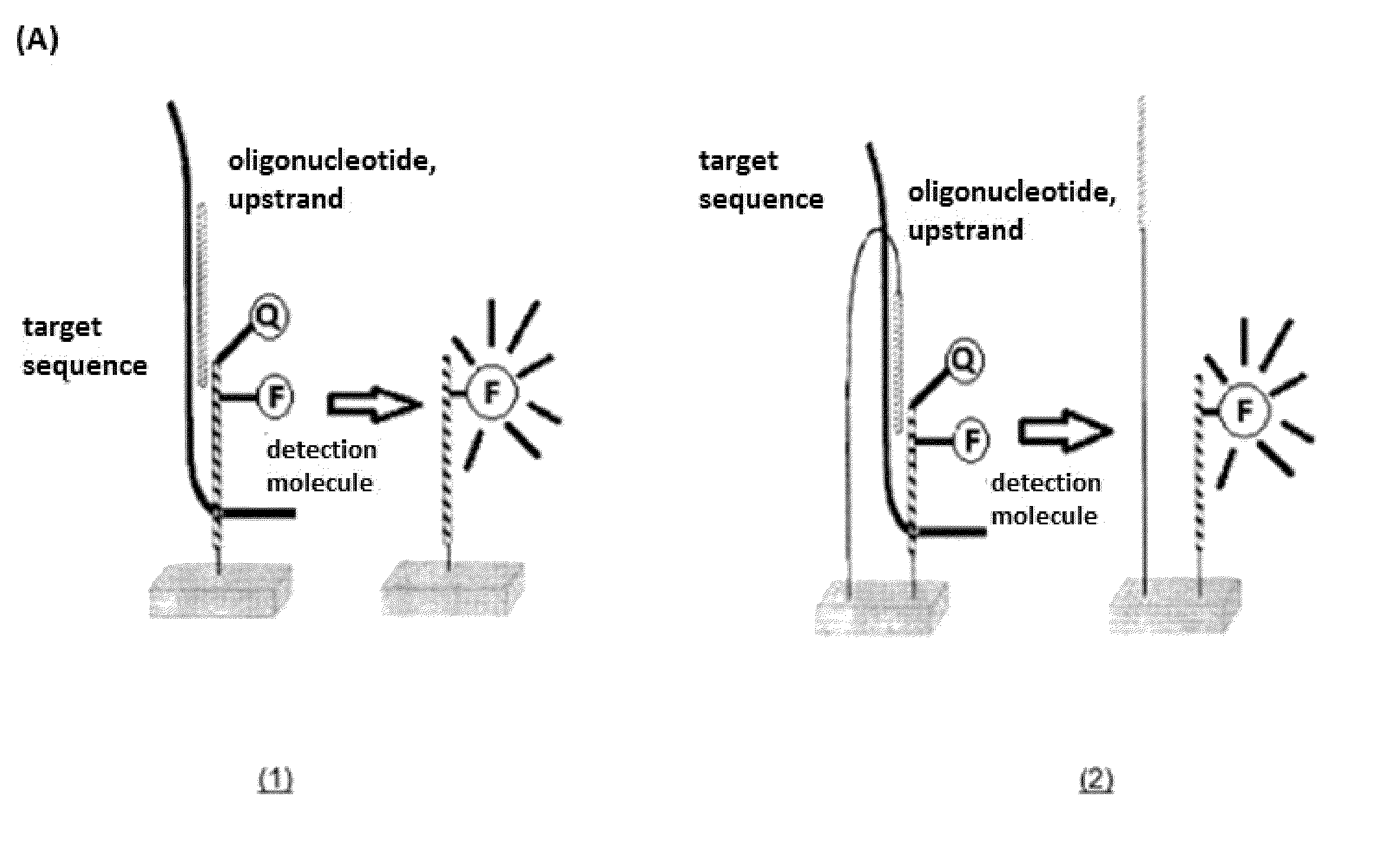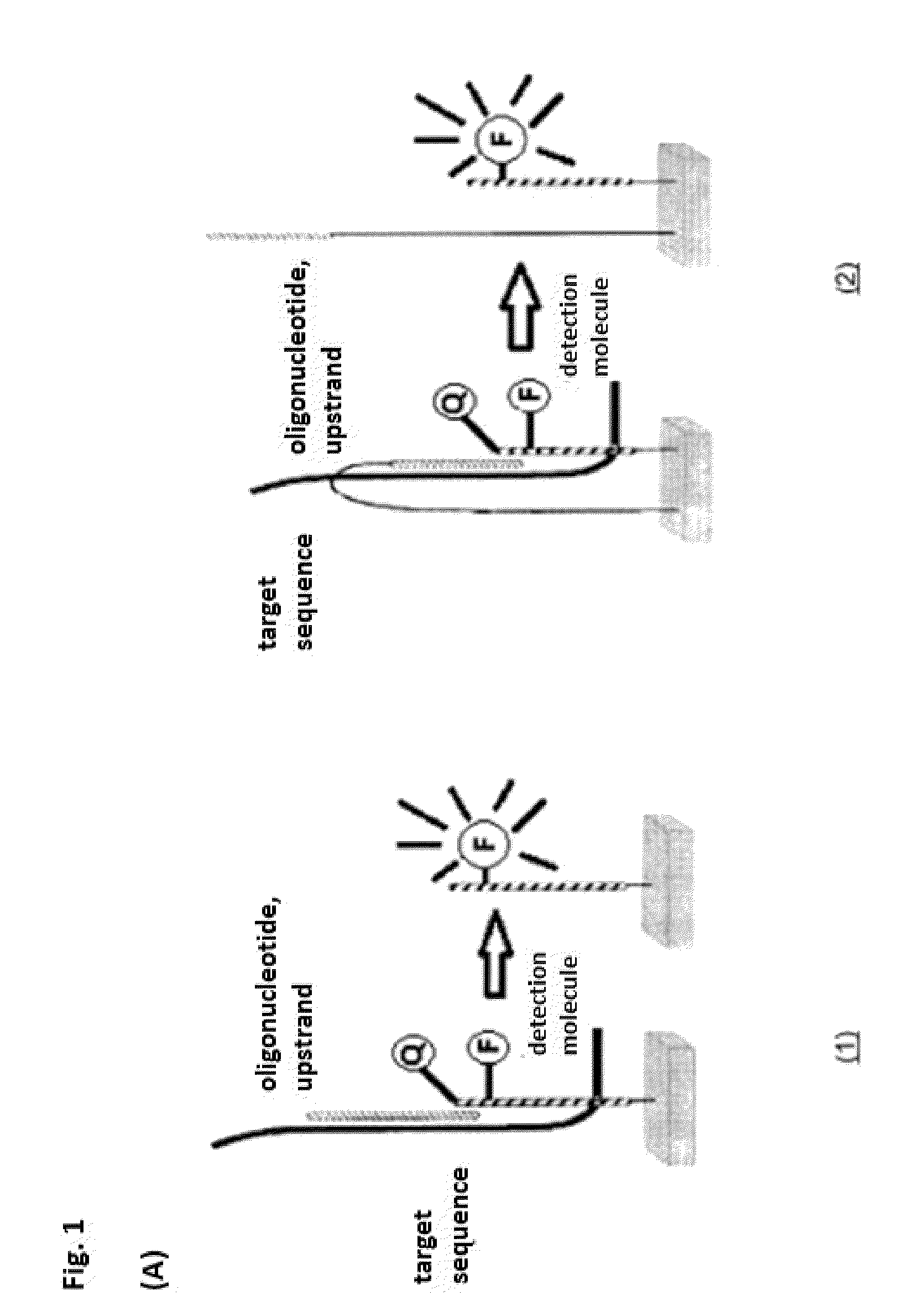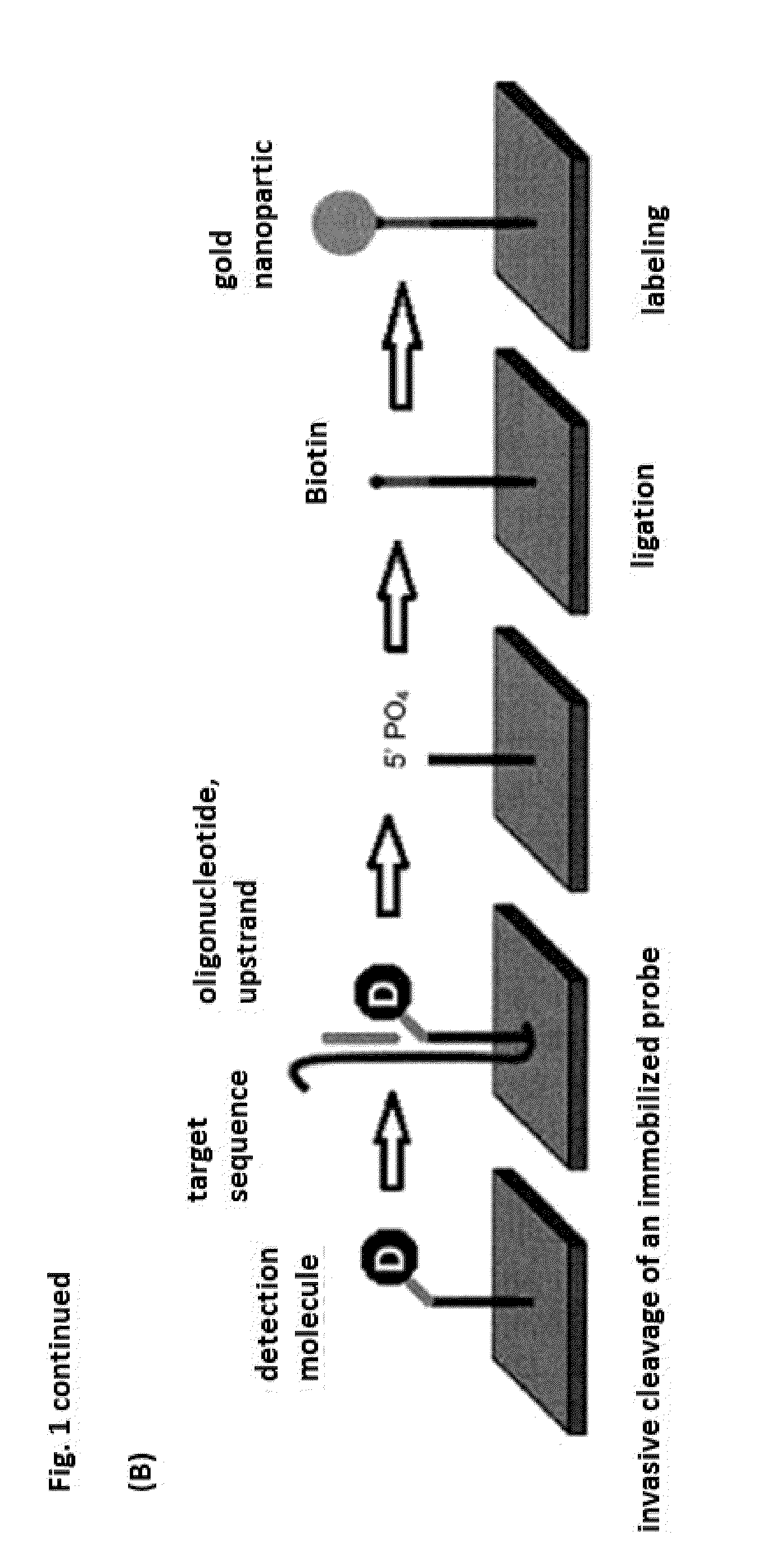As a rule, in situ
lithography methods only allow synthesis of short oligonucleotides and / or
amino acid chains.
This procedure includes several time-consuming steps and increases the risk of inaccuracy and
contamination.
The complex procedural protocol has a negative effect on integration into the work sequence.
Repeated addition and removal of reagents and / or reaction products and also the transfer of the reaction batch between multicontainers involve a great deal of effort (“hands-on time”), long waiting times (“
time to result”) and the risk of procedural errors.
Therefore, this method cannot be adapted to differing target sequences without producing a new
microarray.
Another
disadvantage of these methods is that the sample material must be transferred between two reaction vessels after the amplification, but this may involve procedural errors and
contamination.
Like other state-of-the-art methods, in which a reaction batch must be transferred after performing amplification, there is the risk of
contamination and procedural errors with this batch as well.
One
disadvantage of this method is the need for the various primer molecules to be homogeneous and to be distributed with a sufficient density in the respective spot so that the
nucleic acid strand formed by elongation of the primer can have a sufficient number of additional interaction partners for the next cycles.
This
solid-phase-supported
multiplexing method has the
disadvantage that post-PCR steps (for example, incubation with modified detection oligonucleotides and / or washing steps and incubation steps) must be performed after incorporation of modified nucleotides.
One disadvantage of this approach is the use of target sequence-specific P3 primer molecules, where the sequence correlates directly with the target molecule.
Connection of active actuators to a
biochip is generally regarded as a disadvantage and increases the labor involved.
The sensitivity achieved is too low for clinical diagnostic purposes.
However, the disadvantage is that no specificity is ensured, so that nonspecific amplification products cannot be differentiated.
However, if a preamplification step is needed outside of the microarray, it results in increased labor and a risk of contamination.
Immobilized molecular beacons or
TaqMan probes typically have at least three modifications (group for immobilization,
fluorescence donor and
fluorescence acceptor), so high subsequent costs for production and immobilization of new probes occur immediately when there are any changes in the target sequence or in the array
layout.
One disadvantage is that a large number of target molecules must be present for this to be detectable.
It is impossible to perform the detection method and amplification in parallel.
The sensitivity of these assays is therefore inadequate for investigating many questions.
In principle, this requires the synthesis of a modified array and is a significant time and cost factor.
Working with microarrays thus offers less flexibility with respect to the target molecule to be detected because a modified sequence
layout entails high subsequent costs and
processing effort.
However, through this reaction another step that is susceptible to errors is integrated into the process.
These are very time-intensive methods because of the numerous
processing steps and analysis steps, and there is also risk of contamination because amplified
nucleic acid fragments must be transferred between reaction vessels.
Furthermore, this method is designed only for endpoint measurements.
This method is labor-intensive because of the numerous
processing steps.
Another disadvantage is the low sensitivity of the
assay because no amplification reaction is integrated into the
assay protocol.
Thus, for example, very low
nucleic acid concentrations cannot be detected with sufficient sensitivity.
Furthermore, the additional hybridization steps may lead to interference and thus to unwanted nonspecific reactions or false-positive signals.
One disadvantage here is that these methods use two different proteins and / or
protein-nucleic acid conjugates, which correlate directly with the respective
analyte.
The use of proteins and the methods derived therefrom constitute a major cost factor because of the synthesis.
The disadvantage is that these devices, which are used mainly in clinical diagnostic tests, are compatible only with proprietary consumable materials and their use is limited to clinically relevant markers and parameters (for example, cardiovascular diseases).
Furthermore, their use is greatly limited by the manufacturer because detection reactions can be performed only for certain target molecules for which the manufacturer has released test kits.
In addition, the systems are limited by low multiparameter level, low sensitivity and restricted quantification.
If various individual analyses are performed in parallel for detection of multiple parameters, this is uneconomical on the other hand: the sample solution must be divided into several homogeneous reaction batches in which different target molecules are detected.
One disadvantage here is that due to the division of the sample solutions into “n” aliquots, the quantity of substance in the individual reaction is reduced by a factor of 1 / n, which reduces the sensitivity of the detection reaction accordingly.
Another disadvantage is that the analysis of samples with a low nucleic
acid concentration or
protein concentration is impossible without an
analyte-dependent prior concentration step and / or amplification step because of the low sensitivity of many detection methods.
In the parallel microarray-based analysis of low concentration nucleic acids, preamplification constitutes an additional step, on the one hand, and also entails the problem that homogeneous amplification cannot take place, depending on the initial quantity of substance and the reaction efficiency, while quantitative results are possible only to a limited extent.
Another disadvantage is the need to transfer amplified products between different reaction vessels and devices because not only is this associated with an additional step but also it entails the risk of contamination.
One disadvantage of this method is that it includes several steps: an upstream amplification and / or enrichment, labeling of the target molecules to detect the interaction of the target molecules with the capture molecule as well as several hybridization and washing steps.
In addition, another problem with the direct dependence between the capture molecule and the target molecule as described here is that the immobilization of another probe is necessary when a new experimental question arises, for example, when a different
genotype of a
virus is to be detected.
Another disadvantage is that, because of the complex production process and the high setup costs (configuration of the array, purification of the processing elements), it is economical to produce a sequence
layout only if large numbers are produced (
scale effects).
This limited flexibility reduces the
advantage of the highly parallel and automatable processing.
Detection with universal nucleic acid microarrays whose probes are independent of the target molecule to be detected can overcome this disadvantage but the labor involved with these methods is high so that they have not become successful.
In addition to the technical disadvantages of the universal microarrays described here, so far no biochemical system has become known from the prior art, which allows combined
multiplex analyses in various substance classes, such as nucleic acids and proteins, so that various methods or items of equipment must be used for different types of detection.
One disadvantage is that the target sequence must diffuse to the
solid phase hairpin
oligonucleotide.
 Login to View More
Login to View More 


